
The Asiatic-Pacific Theater was the theater of operations of U.S. forces during World War II in the Pacific War during 1941–1945. From mid-1942 until the end of the war in 1945, two U.S. operational commands were in the Pacific. The Pacific Ocean Areas (POA), divided into the Central Pacific Area, the North Pacific Area and the South Pacific Area, were commanded by Fleet Admiral Chester W. Nimitz, Commander-in-Chief Pacific Ocean Areas. The South West Pacific Area (SWPA) was commanded by General of the Army Douglas MacArthur, Supreme Allied Commander South West Pacific Area. During 1945, the United States added the United States Strategic Air Forces in the Pacific, commanded by General Carl A. Spaatz.

USS Mustin (DD-413) was a Sims-class destroyer of the United States Navy, the first Navy ship of that name, in honor of Captain Henry C. Mustin (1874–1923), a pioneer of naval aviation.
During World War II, the United States Army divided its operations around the world into four theaters. Forces from many different Allied nations fought in these theaters. Other Allied countries have different conceptions of the theaters and/or different names for them.
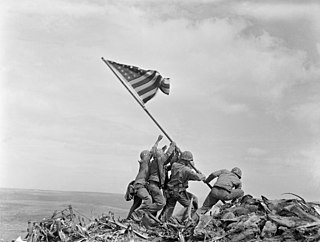
The Pacific War, sometimes called the Asia–Pacific War, was the theater of World War II that was fought in eastern Asia, the Pacific Ocean, the Indian Ocean, and Oceania. It was geographically the largest theater of the war, including the vast Pacific Ocean theater, the South West Pacific theater, the Second Sino-Japanese War, and the Soviet–Japanese War.

The third USS Farragut (DD-348) was named for Admiral David Glasgow Farragut (1801–1870). She was the lead ship of her class of destroyers in the United States Navy.

The Asiatic–Pacific Campaign Medal is a United States military award of the Second World War, which was awarded to any member of the United States Armed Forces who served in the Asiatic-Pacific Theater from 1941 to 1945. The medal was created on November 6, 1942, by Executive Order 9265 issued by President Franklin D. Roosevelt. The medal was designed by Thomas Hudson Jones; the reverse side was designed by Adolph Alexander Weinman which is the same design as used on the reverse of the American Campaign Medal and European-African-Middle Eastern Campaign Medal.

The Aleutian Islands campaign was a military campaign fought between 3 June 1942 and 15 August 1943 on and around the Aleutian Islands in the American Theater of World War II. It was the only military campaign of World War II fought on North American soil.

USS Hutchins (DD-476), was a Fletcher-class destroyer, of the United States Navy named after Naval aviator Lieutenant Carlton B. Hutchins (1904–1938), who though mortally injured, was able to remain at the controls of his aircraft and allow his surviving crew to parachute to safety and was posthumously awarded the Medal of Honor.
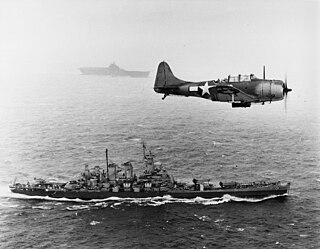
The Gilbert and Marshall Islands campaign were a series of battles fought from August 1942 through February 1944, in the Pacific theatre of World War II between the United States and Japan. They were the first steps of the drive across the Central Pacific by the United States Pacific Fleet and Marine Corps. The purpose was to establish airfields and naval bases that would allow air and naval support for upcoming operations across the Central Pacific. Operation Galvanic and Operation Kourbash were the code names for the Gilberts campaign that included the seizures of Tarawa and Makin, during the Battle of Tarawa on 20–23 November and the Battle of Makin on 20–24 November 1943. Operation Flintlock and Operation Catchpole were aimed at capturing Japanese bases at Kwajalein, Eniwetok, and Majuro in the Marshall Islands.

The Solomon Islands campaign was a major campaign of the Pacific War of World War II. The campaign began with Japanese landings and capture of several areas in the British Solomon Islands and Bougainville, in the Territory of New Guinea, during the first six months of 1942. The Japanese occupied these locations and began the construction of several naval and air bases with the goals of protecting the flank of the Japanese offensive in New Guinea, establishing a security barrier for the major Japanese base at Rabaul on New Britain, and providing bases for interdicting supply lines between the Allied powers of the United States and Australia and New Zealand.

USS Frazier (DD-607) was a Benson-class destroyer in the United States Navy during World War II.
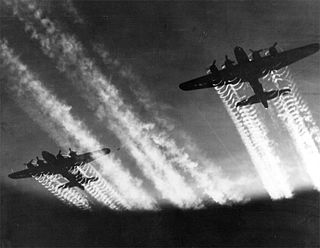
The military history of the United States during World War II covers the nation's role as one of the major Allies in their victory over the Axis Powers. The United States is generally considered to have entered the conflict with the 7 December 1941 surprise attack on Pearl Harbor by the Empire of Japan and exited it with the 2 September 1945 surrender of Japan. During the first two years of World War II, the US maintained formal neutrality, which was officially announced in the Quarantine Speech delivered by US President Franklin D. Roosevelt in 1937. While officially neutral, the US supplied Britain, the Soviet Union, and China with war materiel through the Lend-Lease Act signed into law on 11 March 1941, and deployed the US military to replace the British forces stationed in Iceland. Following the 4 September 1941 Greer incident involving a German submarine, Roosevelt publicly confirmed a "shoot on sight" order on 11 September, effectively declaring naval war on Germany and Italy in the Battle of the Atlantic. In the Pacific Theater, there was unofficial early US combat activity such as the Flying Tigers.
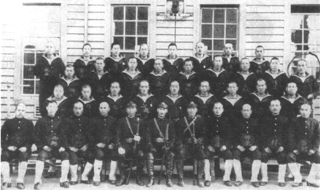
The invasion of Tulagi, on 3–4 May 1942, was part of Operation Mo, the Empire of Japan's strategy in the South Pacific and South West Pacific Area in 1942. The plan called for Imperial Japanese Navy troops to capture Tulagi and nearby islands in the British Solomon Islands Protectorate. The occupation of Tulagi by the Japanese was intended to cover the flank of and provide reconnaissance support for Japanese forces that were advancing on Port Moresby in New Guinea, provide greater defensive depth for the major Japanese base at Rabaul, and serve as a base for Japanese forces to threaten and interdict the supply and communication routes between the United States and Australia and New Zealand.
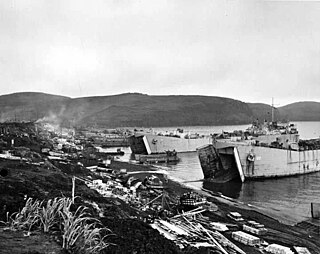
Operation Cottage was a tactical maneuver which completed the Aleutian Islands campaign. On 15 August 1943 Allied military forces landed on Kiska Island, which had been occupied by Japanese forces since June 1942. The Japanese, however, had secretly abandoned the island two weeks earlier, and so the Allied landings were unopposed. Allied forces suffered over 313 casualties in total during the operation from Japanese landmines and booby traps, friendly fire incidents, and vehicle accidents.

USS Heywood (APA-6) was a Heywood-class attack transport acquired by the U.S. Navy for service as a troop carrier during World War II. She served in the Pacific War, a very dangerous area in the early years of the war, and safely returned home post-war with seven battle stars to her credit.

USS Harris (APA-2) was an Emergency Fleet Corporation Design 1029 ship launched for the United States Shipping Board (USSB) on 19 March 1921 by Bethlehem Shipbuilding Corporation, at Sparrows Point, Maryland as Pine Tree State. After operation by commercial lines for the USSB, during which the ship was renamed President Grant and operated commercially until laid up in the late 1930s.

The Japanese occupation of Kiska took place between 6 June 1942 and 28 July 1943 during the Aleutian Islands campaign of the American Theater and the Pacific Theater of World War II. The Japanese occupied Kiska and nearby Attu Island in order to protect the northern flank of the Japanese Empire. Along with the Attu landing the next day, it was the first time that the United States was occupied by a foreign power since the War of 1812, and was one of the two invasions of the United States during World War II.

The Japanese occupation of Attu was the result of an invasion of the Aleutian Islands in Alaska during World War II. Imperial Japanese Army troops landed on 7 June 1942, the day after the invasion of nearby Kiska. Along with the Kiska landing, it was the first time that the continental United States was invaded and occupied by a foreign power since the War of 1812, and was the second of the only two invasions of the United States during World War II. The occupation ended with the Allied victory in the Battle of Attu on 30 May 1943.
 — plan to engage and destroy the U.S. Fleet during the Saipan landings
— plan to engage and destroy the U.S. Fleet during the Saipan landings — invasion of the western Aleutians as a diversion from the attempted invasion of Midway Island
— invasion of the western Aleutians as a diversion from the attempted invasion of Midway Island  — seizure of Kiska Island
— seizure of Kiska Island  — seizure of Attu Island
— seizure of Attu Island  — evacuation of Kiska, Aleutians
— evacuation of Kiska, Aleutians  — major air offensive to halt Allied advances on New Guinea and Guadalcanal
— major air offensive to halt Allied advances on New Guinea and Guadalcanal  — proposal to isolate Australia by capturing New Caledonia, Samoa and Fiji
— proposal to isolate Australia by capturing New Caledonia, Samoa and Fiji  — reconnaissance and air-raid on Pearl Harbor
— reconnaissance and air-raid on Pearl Harbor  — plan to destroy the U.S. Fleet and recapture Guadalcanal
— plan to destroy the U.S. Fleet and recapture Guadalcanal  — evacuation of Guadalcanal
— evacuation of Guadalcanal  — plan to counter U.S.-led invasion of Japan
— plan to counter U.S.-led invasion of Japan  — attempted seizure of Midway Island
— attempted seizure of Midway Island  — aborted invasion of Port Moresby in New Guinea
— aborted invasion of Port Moresby in New Guinea  — attempt to take Allied airfields on Milne Bay in New Guinea
— attempt to take Allied airfields on Milne Bay in New Guinea  — reinforcement of air forces at Rabaul
— reinforcement of air forces at Rabaul  — naval reaction to U.S. invasion of Leyte
— naval reaction to U.S. invasion of Leyte  — seizure of Lae and Salamaua in southeast New Guinea
— seizure of Lae and Salamaua in southeast New Guinea  — attempt to repulse U.S. beachhead on Bougainville Island
— attempt to repulse U.S. beachhead on Bougainville Island  — long-range Kamikaze mission on Allied fleet anchorage at Ulithi atoll
— long-range Kamikaze mission on Allied fleet anchorage at Ulithi atoll — air defense plan for Japan
— air defense plan for Japan — kikusui attacks and naval sortie to defend Okinawa.
— kikusui attacks and naval sortie to defend Okinawa. — the Japanese attack on Pearl Harbor
— the Japanese attack on Pearl Harbor 















